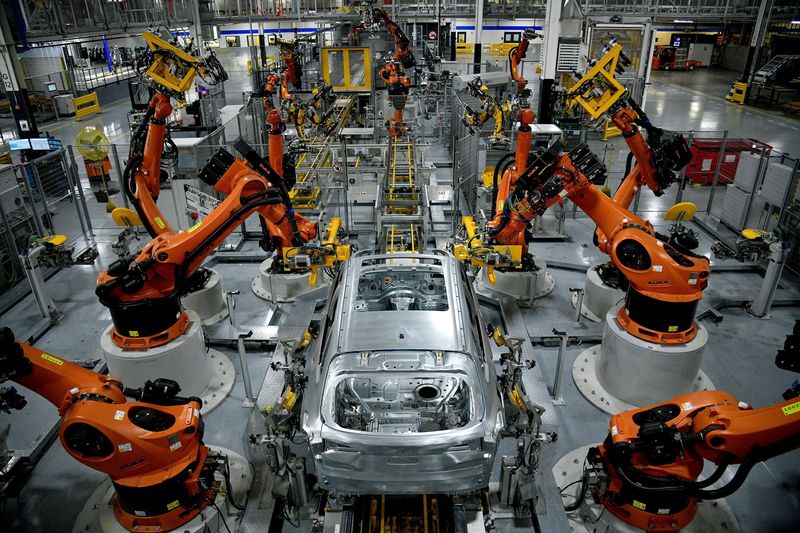WASHINGTON (Reuters) – U.S. manufacturing activity slowed in December amid a cooling in demand for goods, but supply constraints are starting to ease and a measure of prices paid for inputs by factories fell by the most in a decade.
The Institute for Supply Management (ISM) survey on Tuesday also suggested some improvement in labor supply, with a gauge of factory employment rising to an eight-month high. Still, Timothy Fiore, chair of the ISM manufacturing business survey committee, noted that “shortages of critical lowest-tier materials, high commodity prices and difficulties in transporting products continue to plague reliable consumption.”
The survey does not fully capture the impact of the Omicron COVID-19 variant, which is rapidly spreading across the United States and abroad. Sky-rocketing infections could force workers to stay home and halt the tentative supply-chain progress.
“There’s still a lot of ground to make up before supply chains fully normalize, but cooling prices and increased employment are positive signs,” said Will Compernolle, a senior economist at FHN Financial in New York.
The ISM’s index of national factory activity fell to a reading of 58.7 last month, the lowest level since January 2021, from 61.1 in November. A reading above 50 indicates expansion in manufacturing, which accounts for 11.9% of the U.S. economy.
Economists polled by Reuters had forecast the index would fall to 60.1.
All of the six biggest manufacturing industries – chemical products, fabricated metal products, computer and electronic products, food, transportation equipment, and petroleum and coal products – reported moderate-to-strong growth.
Manufacturers of fabricated metal products expressed optimism that “we have reached the top of the hill to start down a gentle slope that lets us get back to something that resembles normal.” Their counterparts in the chemical products industry said the “gut feeling says it’s getting easier to source chemical raw materials.”
Machinery makers reported that “costs for steel seem to be coming down some.” They also noted improvements in “performance by suppliers” and “on-time deliveries.” But transportation equipment manufacturers said capacity remained “limited due to the global chip shortage.”
The ISM survey’s measure of supplier deliveries declined to a reading of 64.9 from 72.2 in November. A reading above 50% indicates slower deliveries to factories.
The ISM’s Fiore said transportation networks, a harbinger of future supplier delivery performance, were still performing erratically, but there are signs of improvement.
Raw materials have been in short supply as global economies rebounded from the coronavirus pandemic. Shortages have also been exacerbated by the shift in demand to goods from services early in the pandemic. Millions of workers needed to produce and move raw materials remain sidelined. (Graphic: More jobs than jobseekers, https://graphics.reuters.com/USA-FED/JOBS/egvbkmeoepq/chart.png)
U.S. stocks were trading mixed, with the Dow Jones Industrial Average and the S&P 500 index having hit fresh record highs earlier in the session. The dollar was flat against a basket of currencies. U.S. Treasury prices were mostly lower.
PRICE GAUGE FALLS
The nascent signs of improvement in supply chains suggest inflation at the factory gate could soon begin to subside.
The survey’s measure of prices paid by manufacturers tumbled to 68.2 last month, the lowest level since November 2020, from 82.4 in November. The 14.2-point plunge was the biggest since October 2011.
This supports the Federal Reserve’s long-held view that the current period of high inflation is transitory. Inflation is well above the U.S. central bank’s flexible 2% target.
“The report is consistent with our expectation that inflation will hit an inflection point probably in the first quarter of this year,” said Tim Quinlan, a senior economist at Wells Fargo in Charlotte, North Carolina.
The ISM survey’s forward-looking new orders sub-index fell to a still-high reading of 60.4 from 61.5 in November. With customer inventories remaining depressed, the slowdown in new order growth is likely to be temporary or limited.
Factories hired more workers, but turnover rates remained high, a trend which manufacturers said started in August.
Indeed, a separate report from the Labor Department on Tuesday showed a record 4.5 million Americans voluntarily quit their jobs in November, which will put pressure on businesses to raise wages to attract workers.
“Replacing those workers is proving unusually challenging,” said Julia Pollak, chief economist at ZipRecruiter. “This is the tightest labor market ever.”
There were 10.6 million job openings at the end of November. The high number of vacancies meant there was 0.65 unemployed person per job opening, an all-time low. Before the pandemic, there were normally about 2.3 unemployed people per job opening. (Graphic: Quitting en masse, https://graphics.reuters.com/USA-ECONOMY/znpnelbrxvl/chart.png)
The ISM’s measure of manufacturing employment rose to an eight-month high of 54.2 from 53.3 in November. This, together with very low first-time applications for unemployment benefits, supports the view that job growth accelerated in December.
According to a preliminary Reuters survey of economists, nonfarm payrolls likely increased by 400,000 jobs in December after rising by 210,000 in November. The Labor Department is scheduled to publish December’s employment report on Friday.
(Reporting by Lucia Mutikani; Editing by Chizu Nomiyama and Paul Simao)






















